Electus Versio Manual#
Not quite a reverb, not quite a delay: the clocked atmosphere generator you never knew you needed
Overview#
Not quite a reverb, not quite a delay, Electus is Desmodus's more aggressive clocked counterpart: more distortion, more in-your-face atmospheres, and synced delays for creating your tails in a whole new way. Use it as a spacey clocked delay, as a reverb that starts with some synced echoes, or as a completely new way to create evolving spaces.
Not only is EV a unique atmosphere generator, it's a stereo DSP platform. A simple USB connection allows you to update EV to a variety of firmwares. Open-source support is available, too, which allows you to write your own firmware! All info can be found on the World of Versio page here.
- Type: Stereo delay/reverb/both?
- Size: 10HP
- Depth: 1.5 inches
Etymology#
Electus -- from Latin: "to pass on" Versio -- from Latin: "versatile"
"Passed Versatility"
Power#

To power your Versio, turn off your case. Plug one end of your ribbon cable into your power board so that the red stripe on the ribbon cable is aligned to the side that says -12 V and each pin on the power header is plugged into the connector on the ribbon. Make sure no pins are overhanging the connector! If they are, unplug it and realign.
Line up the red stripe on the ribbon cable so that it matches the white stripe and/or -12 V indication on the board and plug in the connector.
Screw your module into your case before powering on the module. You risk bumping the module's PCB against something metallic and damaging it if it's not properly secured when powered on.
If your Versio looks like the left picture, it requires 70mA +12v and 70mA -12v. If it looks
like the right picture, it requires 125mA +12v and 10mA -12v. Versio does not use the
+5v rail.
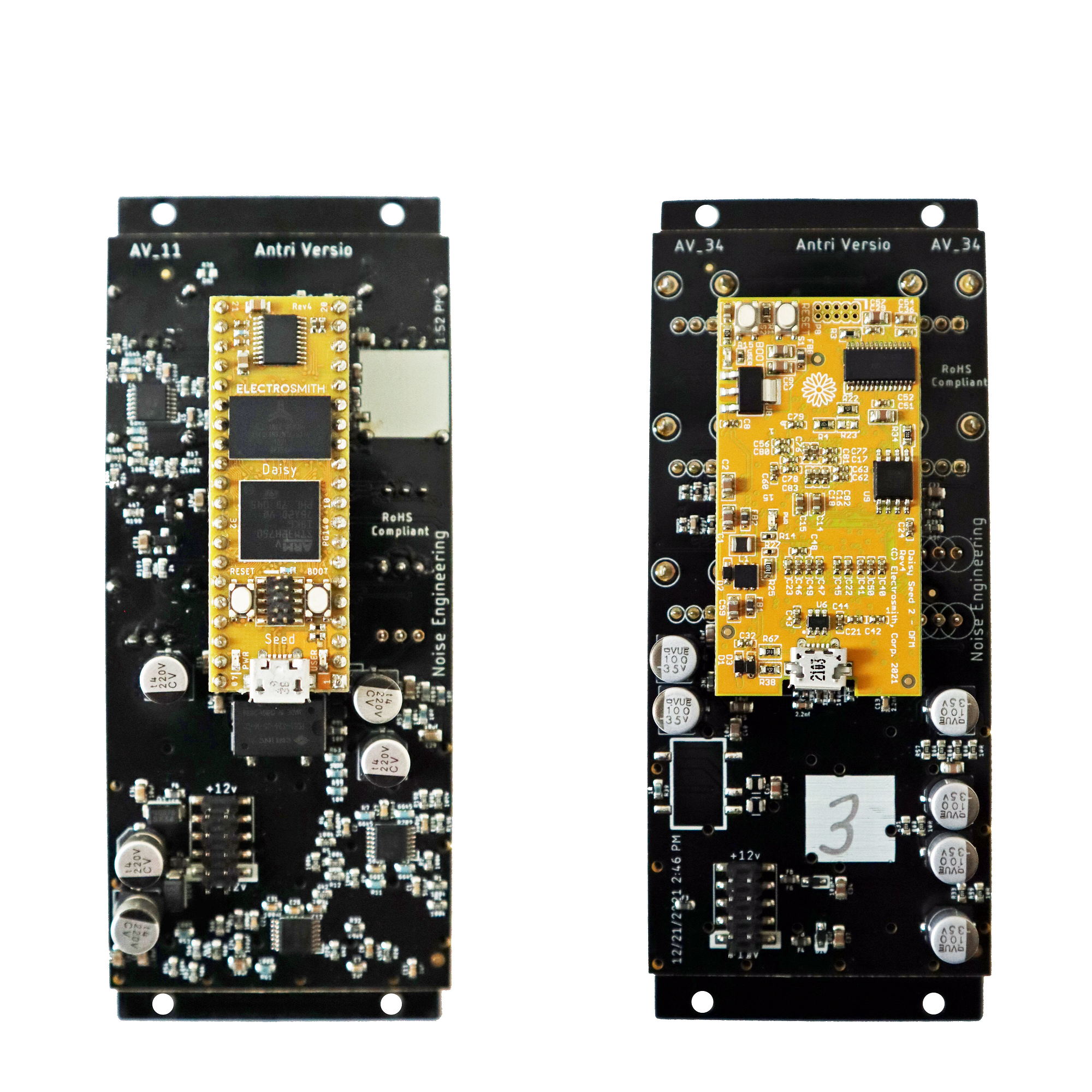
You should be good to go if you followed these instructions. Now go make some noise!
Color code#
On boot, the Electus Versio's LEDs will shine with this color pattern to indicate that it is running the current Electus Versio firmware:
Input & output voltages#
All CV inputs expect 0 V to 5 V. All pots act as offsets and sum with the input CV. The Gate input responds to signals above +2 V. The audio inputs clip around 16 V peak to peak.
A note about Electus Versio's parameters#
Electus Versio's parameters are very similar to the original Desmodus. In fact, the only parameters that perform a different function are Tap (formerly FSU) and L/C/R (formerly BND/LRP/JMP). Additionally, in clocked mode, Size acts as a clock multiplier/divider.
Interface#

- Blend (Blend)
- Dry/wet balance control. When turned fully left, the unmodified input signal is passed through. Fully right, only the processed signal is heard. Points in the middle give you a mix of both.
- Tone
- A filter in the reverb tank. This is a bipolar control: turning the knob to the left controls a lowpass filter, and to the right controls a highpass filter. In the center, the filter is disabled.
- Regen
- Amount of feedback. Regen controls a wide range of tones and behaviors. All the way to the left, feedback is minimized. As you turn up to about 12:00, Electus Versio generates shorter, tamer tails and delays. Past this point, the atmosphere reaches 100% feedback, creating infinite and evolving tails. Past 3:00, the tails are ducked by new sounds at the input, creating sidechain-type effects.
- Speed
- The speed of the internal LFO.
- Index
- The amount of LFO sent to the delay lines that make up the effect. This is a bipolar control: in the center the LFO is disabled; to the left, the LFO modulates the delay lines randomly. To the right, the LFO modulates the delay lines with a sine wave.
- Size
- The delay time. When unclocked, it sets times from comb-like bursts at the left to long, lush delays at the right. When clocked, it selects from the following clock divisions/multiplications: 1/2, 5/8, 3/4, 7/8, 1/1, 15/4, 3/2, 7/4, 2/1
- Dense
- The spacing of the delay lines. To the left, the effect sounds like a delay, to the right the delays are smeared into reverb.
- Tap
- Tap tempo. Tap in your desired clock rate, or use an external clock. Holding down this button for about two seconds exits clocked mode and returns to free-running mode.
- LIM/DST/SHM
- Atmosphere style.
- LIM (Limit): A clean atmosphere, using limiting to contain feedback.
- DST (Distort): Instead of using limiting, clipping is used to limit feedback creating a more distorted tail.
- SHM (Shimmer): A demonic pitch-shifting algorithm. Adds a one-octave pitch shift that feeds back into the input.
- L/C/R
- Reflection structure: Changes how the delay lines connect with each other.
- In L/In R
- Audio input. If R is not patched, the signal from L is normaled to both inputs.
- Out L/Out R
- Stereo output pair.
Patch tutorial#
- Room
- Patch a sound source to In L (and In R if sound is stereo). Patch Out L and Out R to your mixer. Set Knobs as shown, and flip the switches to LIM and C. Explore different Size and Tone settings to change the shape of your room.

- Big Hall
- Patch a sound source to In L (and In R if sound is stereo). Patch Out L and Out R to your mixer. Set Knobs as shown, and flip the switches to LIM and C. Much of the tone of this atmosphere comes from the Size, Tone and Index interactions. Explore different Speed and Regen values, and listen to the way different L/C/R settings can subtly shift your sounds.
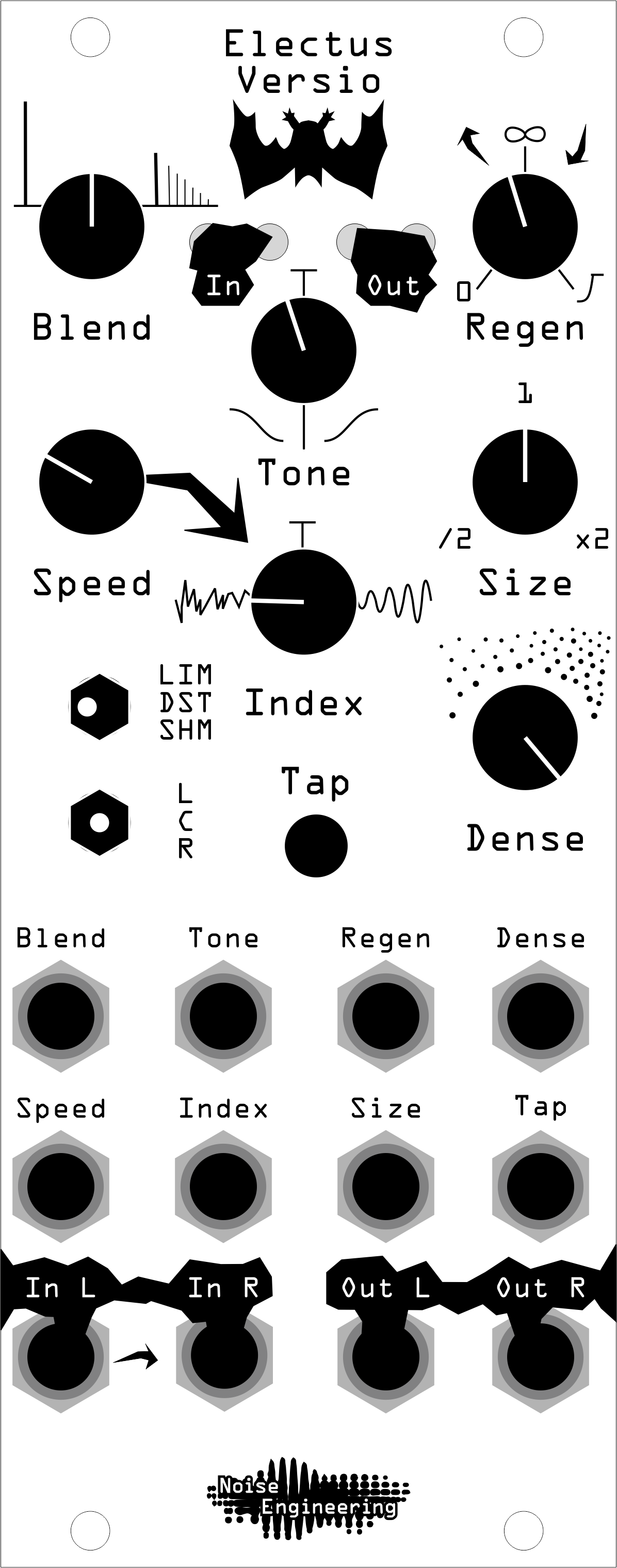
- Light Bright Delay
- Patch a sound source to In L (and In R if sound is stereo). Patch Out L and Out R to your mixer. Set Knobs as shown, and flip the switches to LIM and C. Optionally, patch a clock to Tap, or tap one in with the button. This patch, along with all other delay-type patches, can be used with or without an external clock. Try tapping one in with the Tap button or patching a clock signal to the Tap jack. Use the Size knob to change the clock division/multiplication. Or, clear the clock by unpatching your clock and holding Tap for a few seconds. The Electus will then run off its own clock,controlled by Size.
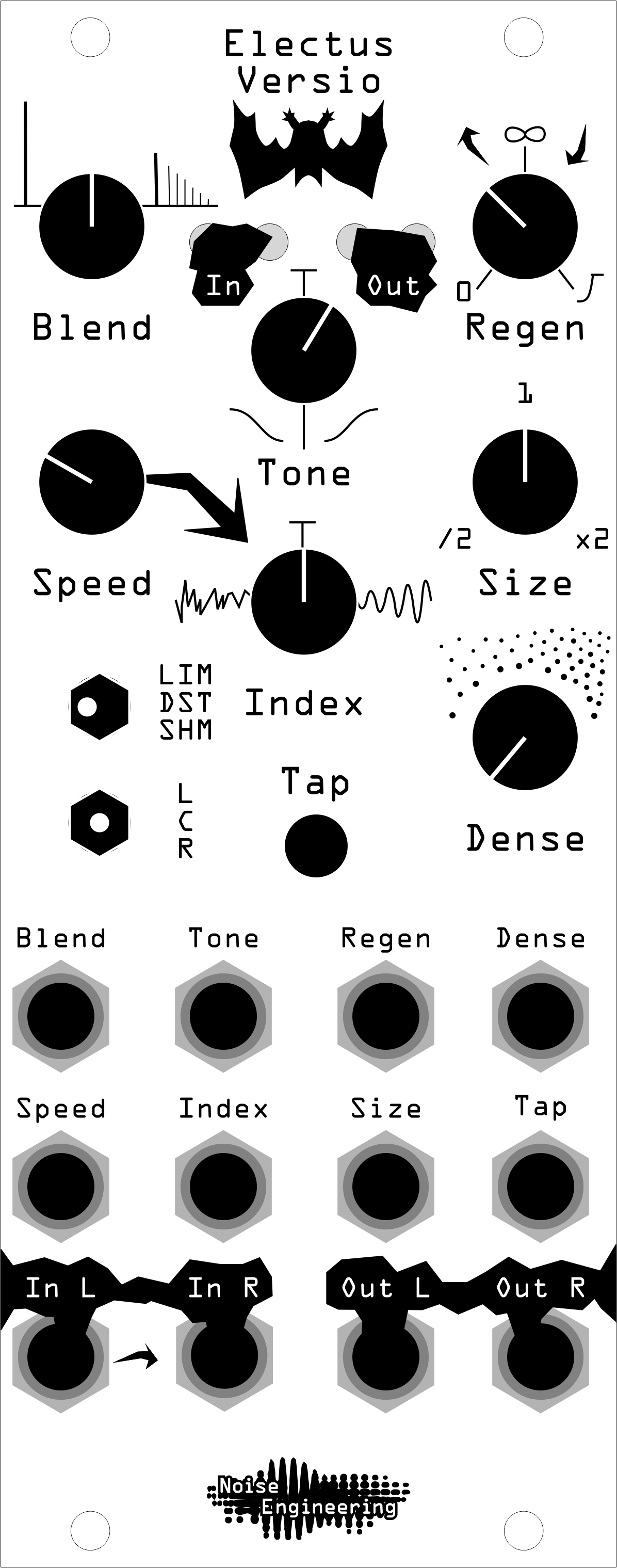
- Tape Warble Delay
- Patch a sound source to In L (and In R if sound is stereo). Patch Out L and Out R to your mixer. Set Knobs as shown, and flip the switches to DST and L. Optionally, patch a clock to Tap, or tap one in with the button. This delay emulates a tape delay by using the DST setting to saturate the echoes, and the Index and Speed controls to modulate the internal delay lines, creating a warble effect. The Tone knob further filters the delay, shaving off the high end of the signal and creating a darker tone. Try turning Regen up to really saturate your delay.
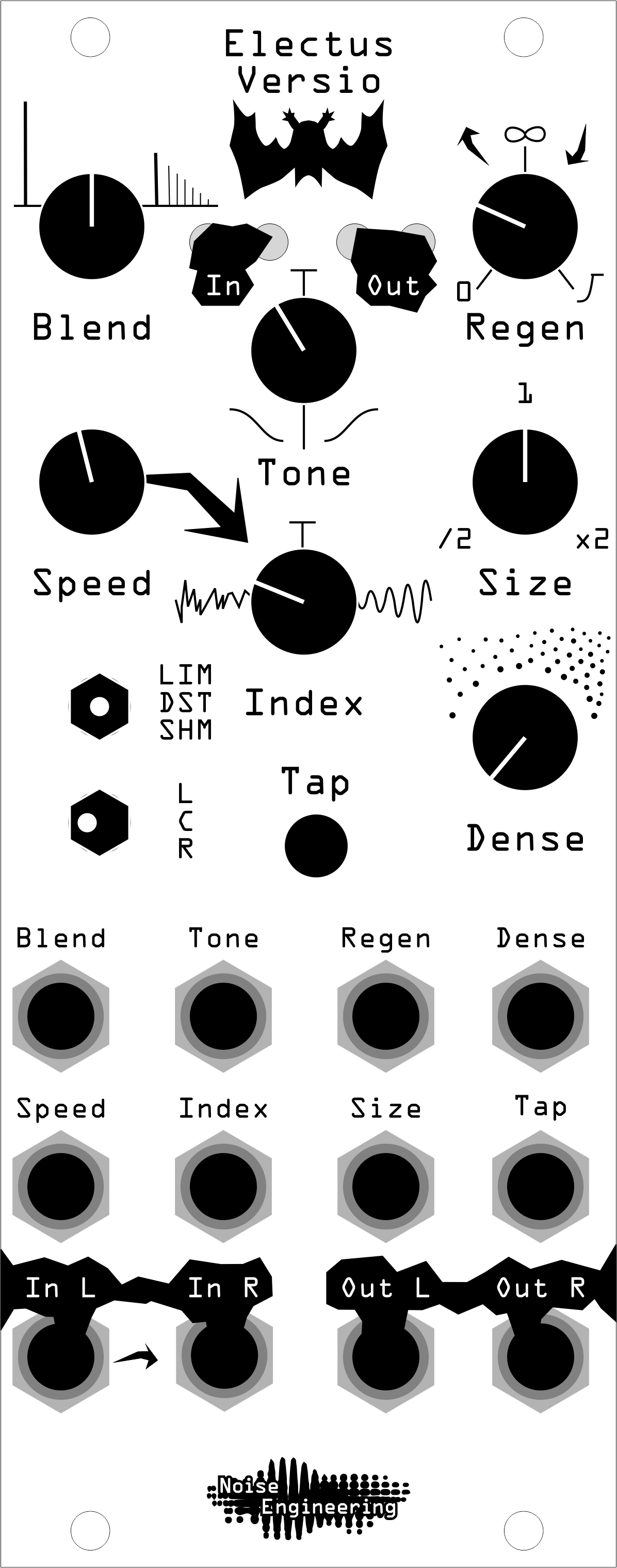
- Shimmery
- Patch a sound source to In L (and In R if sound is stereo). Patch Out L and Out R to your mixer. Set Knobs as shown, and flip the switches to SHM and C. This atmosphere utilizes the Electus’s pitch-shifting shimmer setting. The Tone control can be useful for shaping the highend content generated by pitch shifting, and slight modulation introduced by low Index values creates a pitch warbling effect and further difuses the reverb.
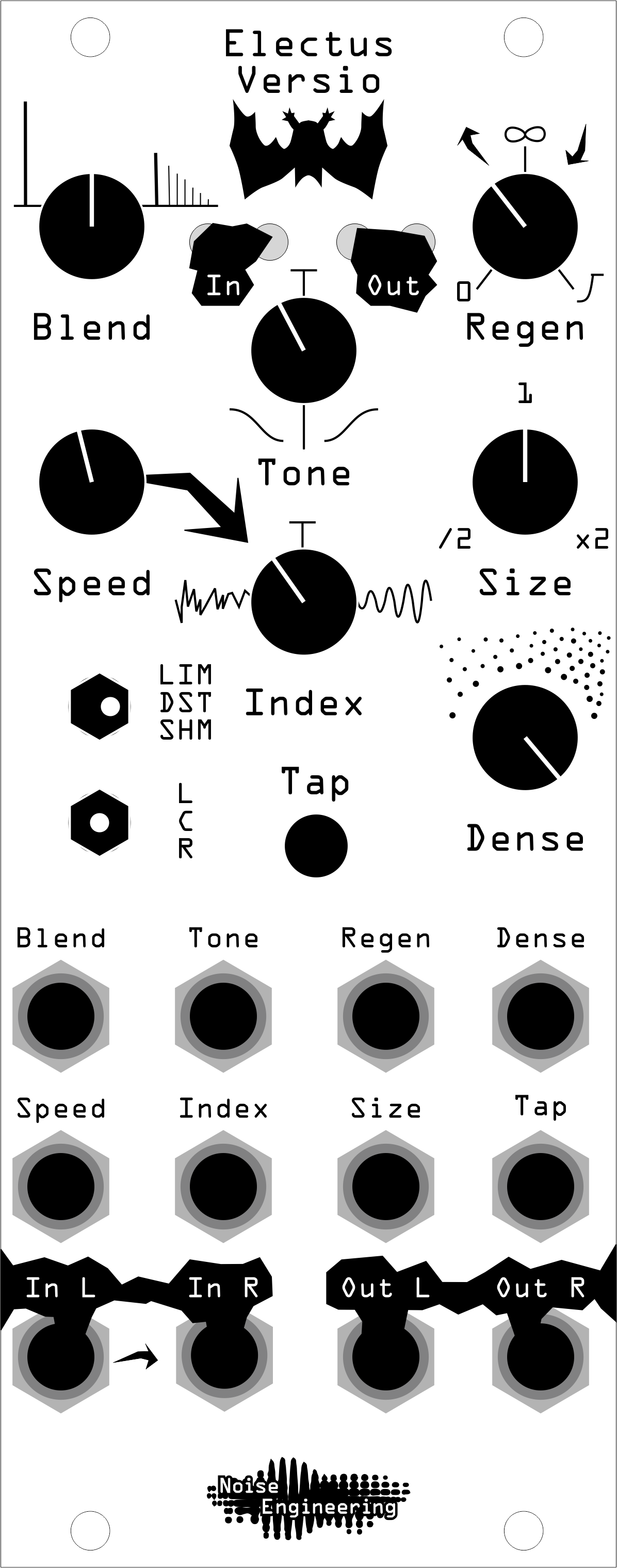
- Drunken Atmosphere
- Patch a sound source to In L (and In R if sound is stereo). Patch Out L and Out R to your mixer. Set Knobs as shown, and flip the switches to DST and C. This atmosphere uses high modulation amounts to create a chaotic texture that really holds its own in a mix.
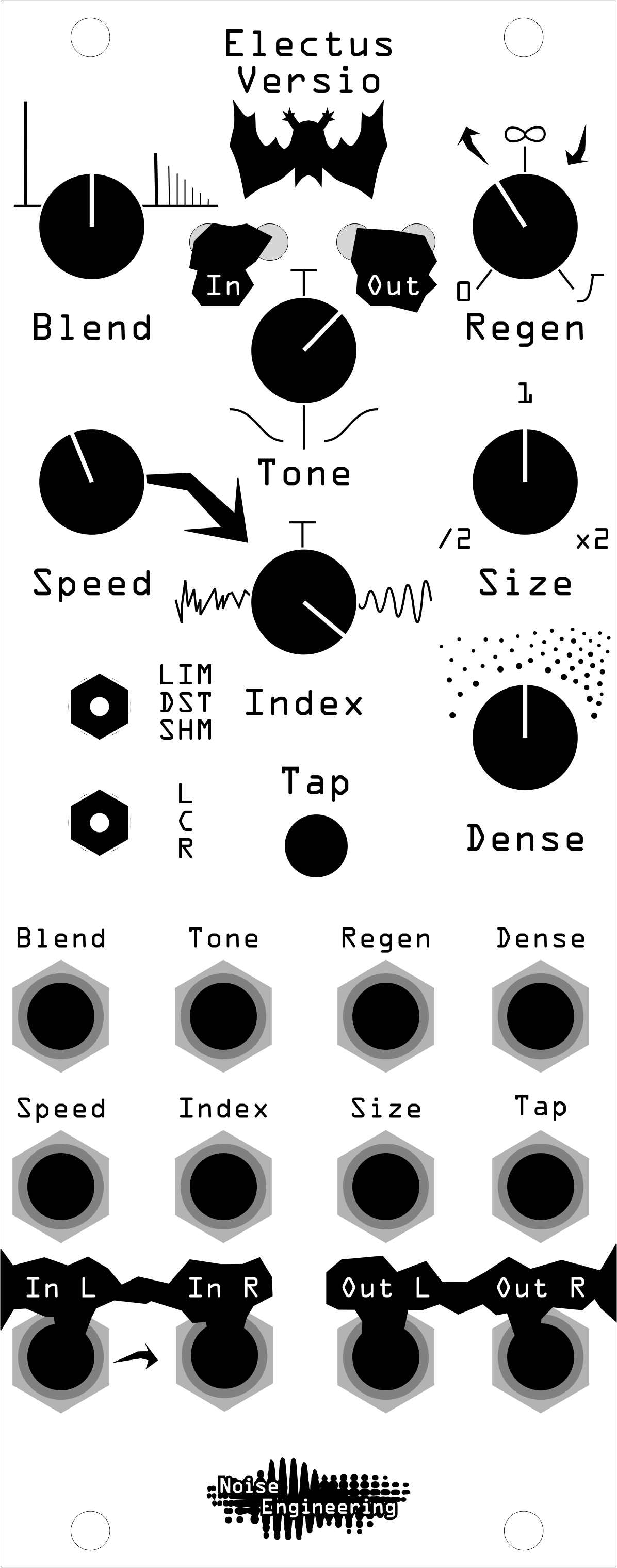
- Kick Ducker
- Patch a percussive, deep sound (like a kick drum) to In L (and In R if sound is stereo). Patch Out L and Out R to your mixer. Set Knobs as shown, and flip the switches to DST and C. This patch uses Electus’s internal ducking effect to create a pumping atmosphere around the input sound. Turning Regen past 3:00 activates the ducking effect.
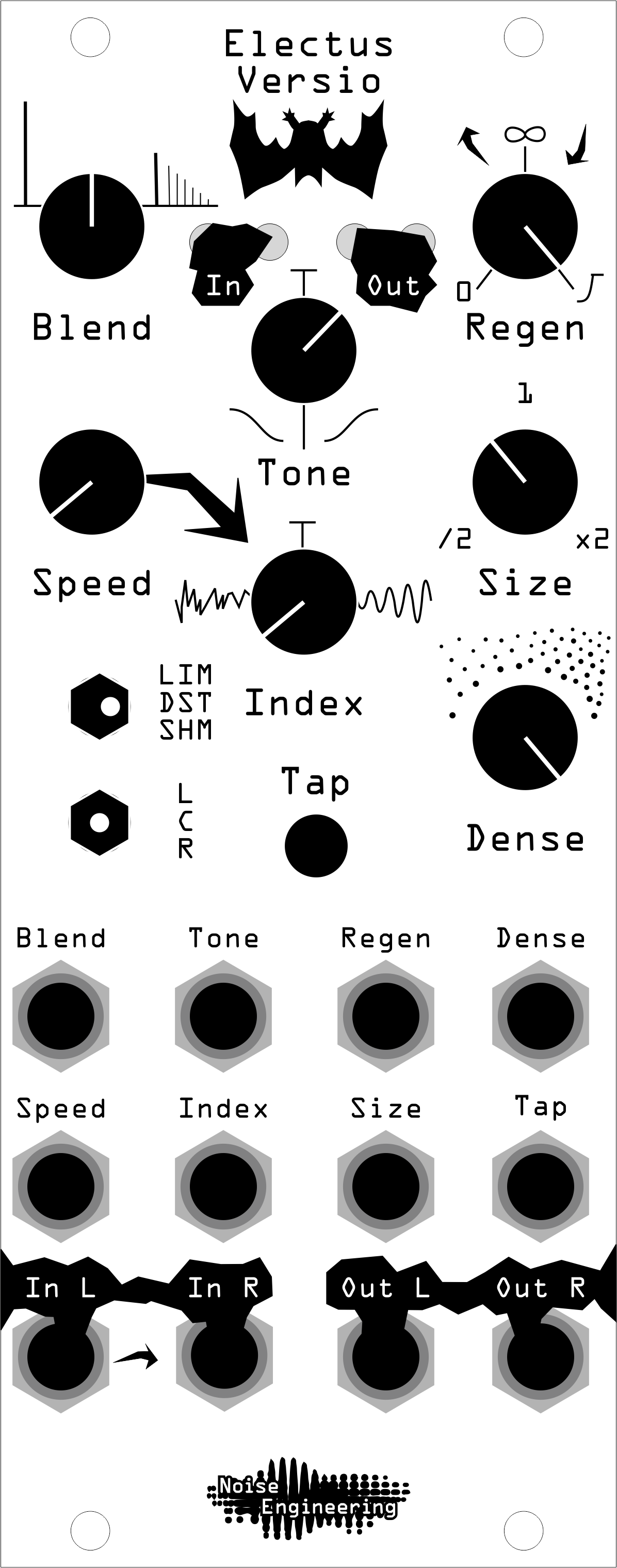
- Evolving Decay
- Patch a sound source to In L (and In R if sound is stereo). Patch Out L and Out R to your mixer. Set Knobs as shown, and flip the switches to LIM and C. Optionally, patch a clock to Tap, or tap one in with the button. This effect is best demonstrated on top of a repeating sequence. Patch it in, and listen as the texture of the atmosphere evolves. It will continue to evolve as time goes on – come back after 10 minutes and hear how the sound differs from the initial atmosphere.
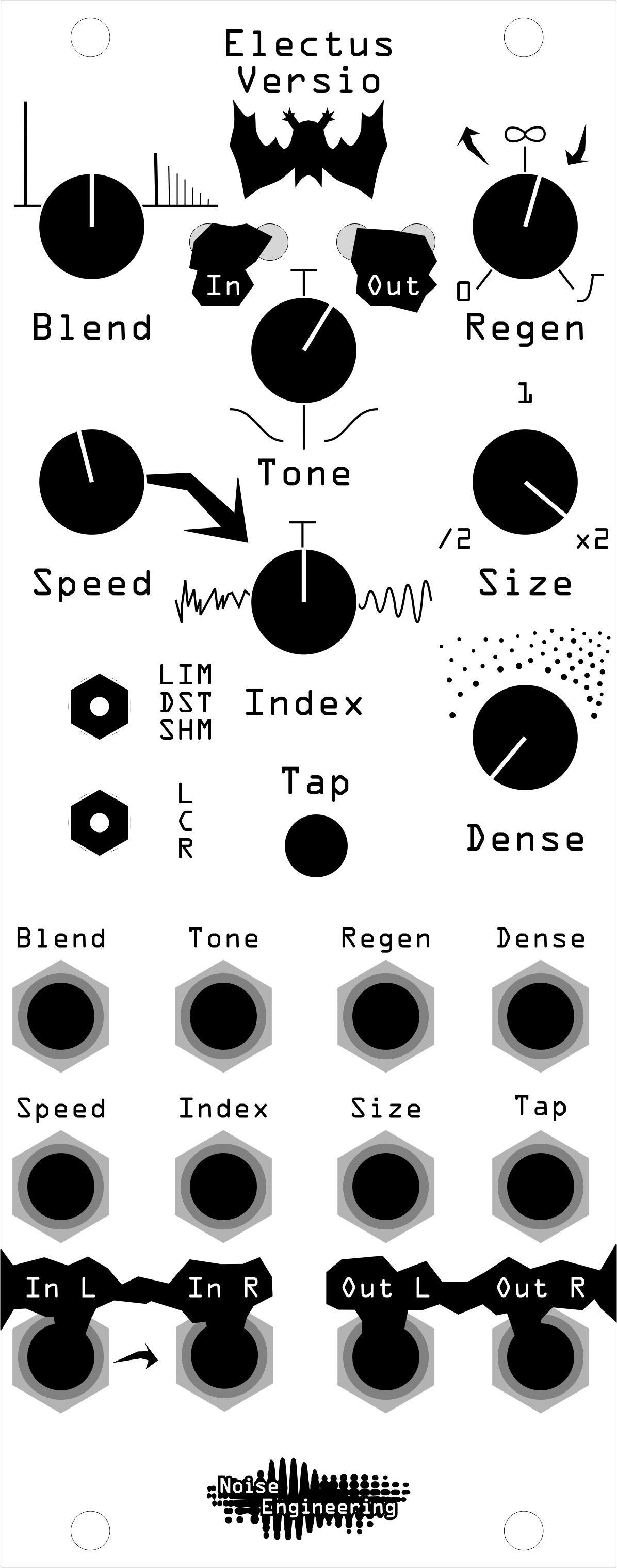
Firmware swapping#
Use our firmware swap app to change your platform module's firmware at any time.
To get started:
- Turn off the power to your case and unscrew the module.
- Remove the power connector on the back of the module.
- Plug a micro USB connector into the port on the pack of the module, and the other end into your computer.
- Follow the instructions in the firmware swap app.
Design notes#
When we released Desmodus Versio, quite a few people asked for it to be clocked. To be honest, a clocked reverb was not something we'd considered: it wasn't how we ever used Desmodus! But we batted the idea around (hah!) and eventually it grew legs (I need to stop).
The problem that prevented Desmodus from tempo syncing was simply that the length of the delay lines was too short to match most reasonable tempos. Why not make them longer? The answer is a bit tricky. The platform we use, the Daisy Seed, has plenty of memory to make them longer but the majority of the memory is too slow for the number of delay lines in Desmodus (32 delays, up to 128 reads per output sample). Desmodus splits the delay lines so some are in faster memory and some are in slower memory and achieves a delicate balance for RAM performance. To increase the delay length the number of delays had to be reduced. The main change with Electus was to reduce the number of delays which required changing the structure of the delays. Electus uses only 16 or 20 delays (depending on the mode). That allows for the base delay time to be 8 times longer than in Desmodus, allowing the delays to be timed to a particular tempo.
Electus is the product of a lot of customers like you asking for a feature that we hadn't considered but turned out to be cool. Although it isn't intended to be dramatically different from Desmodus, we've been surprised at just how different it can sound. It's a bit more distorted, a little more like a delay, synced when you want it to be...some sounds will be similar to what you get out of Desmodus, but definitely not the same. Which effect is right for you? You be the judge -- check them both out for free with the purchase of any Versio module by logging into the NE Customer Portal.
Warranty#
We will repair or replace (at our discretion) any product that we manufactured as long as we are in business and are able to get the parts to do so. We aim to support modules that have been discontinued for as long as possible. This warranty does not apply to normal wear and tear, including art/panel wear, or any products that have been modified, abused, or misused. Our warranty is limited to manufacturing defects.
Warranty repairs/replacements are free. Repairs due to user modification or other damage are charged at an affordable rate. Customers are responsible for the cost of shipping to Noise Engineering for repair.
All returns must be coordinated through Noise Engineering; returns without a Return Authorization will be refused and returned to sender.
Please contact us if you think one of your modules needs a repair.
Special thanks#
All the customers who asked for this!